Brainy Ballplayers
Elite athletes get their heads in the game
Superstar athletes are revered for their physical prowess, not for what goes on between their ears. And most postgame interviews do little to challenge the notion that athletes have more brawn than brains.
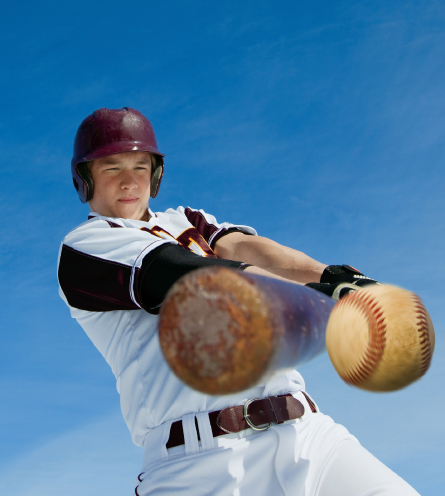
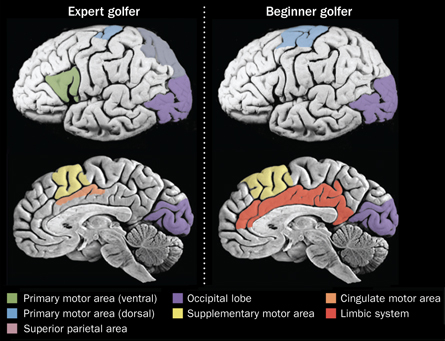
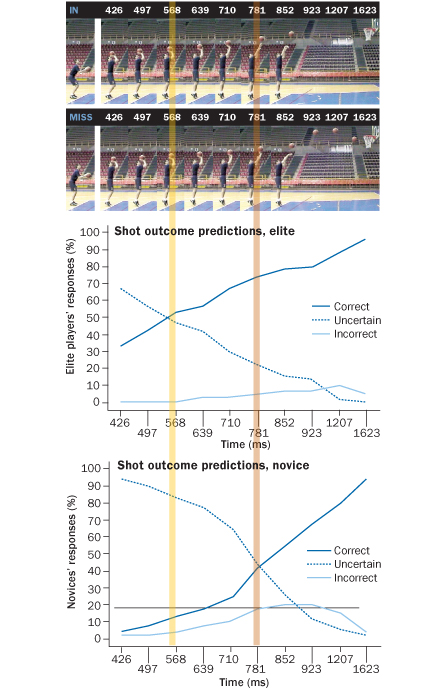
But brainpower has a vital role in elite sports performance, recent research shows.
“Brawn plays a part, but there’s a whole lot more to it than that,” says John Milton, a neuroscientist at the Claremont Colleges in California.
Whether on the court, field or course, the body depends on the brain for direction. But the brain is a busy taskmaster, with duties beyond guiding motion, making it difficult to focus on that particular job. Like chess masters and virtuoso musicians, superior athletes are better than novices at turning on just the parts of the brain relevant to the desired task, Milton’s work reveals. “In professionals, the overall brain activation is much lower, but certain connections are enhanced,” he says. In other words, experts employ only the finely tuned neural regions that help enhance performance, without getting bogged down by extraneous information.
Elite athletes’ ability to focus the brain might even explain their struggle to eloquently describe performance after the game. Like a starship captain diverting power from life support to bolster shields in a battle, professional athletes temporarily shut down the memory-forming regions of the brain so as to maximize activity in centers that guide movement.
“That’s why they usually thank God or their moms,” says cognitive psychologist Sian Beilock of the University of Chicago. “They don’t know what they did, so they don’t know what else to say.”
It’s not stupidity; it’s selectivity. And in the last few years scientists have been able to visually capture this concentrated, purposeful neural concert that takes place in the expert athlete’s brain. But even these vibrant brain scans reveal only part of the success story. Other recent studies demonstrate how athletes’ brains seamlessly interact with the muscular system to perfect and deploy movements — and how the athletic brain anticipates actions in advance and updates planned responses as needed.
By examining how such brain processes lead to excellence in sports, as well as what goes wrong when athletes blow it in the big game, scientists think they can enhance training techniques and improve performance under pressure.
In the zone
Using functional MRI scans to monitor blood flow in the brain, Milton and his colleagues have identified the regions essential for expert-level motor skill: the superior parietal and premotor areas. These regions, two of the brain’s motor centers, primarily move the body toward a visually perceived goal and direct complex motion. In brain scans of professional golfers planning a shot, these areas showed heightened activity, Milton and colleagues reported in 2007 in NeuroImage. In contrast, the study found that the brains of beginner golfers preparing a swing showed much more dispersed activity — especially pervasive in the basal ganglia and limbic system, regions of the brain that control emotions and make people consciously aware of their movements.
Such differences in brain activity reflect the players’ different concerns. “The novices were worried about all kinds of things — wind, water and sand,” Milton says. “The pro golfers just hit the ball.”
Yogi Berra once famously quipped that he couldn’t “think and hit at the same time,” and Milton believes that devoting too much conscious attention to swing mechanics could actually hurt performance, even among big leaguers. His research suggests that when professional golfers think too long about their shots, the athletes activate parts of their brains that they haven’t used during golf since first learning the game, throwing finely tuned sensorimotor pathways out of whack. “This is because the expert’s brain has already figured out the optimal solution, and anything they consciously change will disrupt that,” Milton says.
The experience of “being in the zone” could simply be what happens when the brain regions making athletes conscious of their movements are finally quieted and motor centers get free rein to guide the players to victory.
Such an ability to perform a complex motor task without thinking, also called automaticity, gives an athlete a big advantage in competition. But to access a complex movement subconsciously, the athlete must first rehearse the motion countless times in training, fully developing the nerve connections essential for expert muscle control. “Practice may not make perfect, but it makes permanent,” Milton says.
How close an athlete can get to perfection through training may be driven by attributes a person is born with. “It depends on the way the neurons connect to the muscles, and that can’t change,” says Daniel Wolpert of the University of Cambridge in England.
The way the nervous system interacts with the musculoskeletal system isn’t flawless. Transmission errors along the way serve as a sort of sensory static, or “noise,” that prevents the muscles from hearing the message the brain is sending. Static can also disrupt messages that sensory organs such as the eyes and skin send to the brain, leaving an athlete with a distorted image of the state of the game.
Players with less noise gumming up their sensorimotor systems are predisposed to athletic glory. With fewer disruptions, these athletes are able to elicit strong, fast muscle contractions that are incredibly accurate, cheating what scientists call the speed-accuracy, or energy-accuracy, trade-off. Unlike most people, expert athletes don’t have to slow down to improve their execution.
A lucky few are granted this genetic head start, but anyone can “train muscles and refine a way of moving that reduces the bad consequences of the noise that’s already there,” Wolpert says.
So training is not only about building bulk to overpower an opponent, but also about teaching more nerve and muscle fibers to work in unison to hone one’s movements. Scientists think brain cells known as mirror neurons may help.
The value of reflection
When a person watches someone else performing an action, the same neurons that would fire if the observer were replicating that action become active — even if that observer is standing completely still. This neural activity is the brain’s way of simulating the motion being witnessed, and can help an athlete reproduce those movements. Mirror neurons thus provide “a system for matching what you do with what you see others doing,” says Salvatore Aglioti of Sapienza University of Rome.
The mirror system may also mediate another important function in the athlete’s brain — anticipation. If mirror neurons are already simulating the motions of an opponent, an observing athlete might use information from those neurons to chart out the full course of the adversary’s motion. In sports where time is of the essence, the ability to predict a movement offers a major leg up.
Based on his knowledge of the mirror system, Aglioti hypothesized that athletes focus attention not solely on the ball, for example, but also on their opponents’ bodies to gain clues that will help in deciding whether to expend energy on a certain response. He studied how well expert basketball players, novices and expert watchers including coaches gauged the result of a free throw based solely on time-lapse photographs depicting various stages of another player’s shooting motion, reporting the findings in 2008 in Nature Neuroscience.“Compared to novices and scouts, elite athletes were better at predicting the outcome of a shot after watching the body motion of basketball players,” Aglioti says.
Expert cricket batters also appear to gain important information from the physical details of an opponent’s throwing motion, suggests a team of Australian researchers. After showing study participants sequential photographs of a bowler in motion, the scientists found that elite batters’ ability to predict the final location of a ball in flight was impaired when the researchers blocked out the arm or hand of the hurling bowler. Novices were equally bad at predicting where the ball was headed regardless of whether they could see the bowler’s arm or hand.
What’s more, anticipation abilities improved among expert batters when they were allowed to fully swing their bat while making a prediction, compared with predicting while standing still or while only completing the lower-body motion of a swing, the Australian team reported last year in Acta Psychologica. Novices’ predictive ability did not improve when they picked up the bat, suggesting that success in sports is partly dependent on how effectively the brain couples the body’s perceptive machinery to its motor processes.
Milton has suggested that athletes in all fast-ball sports — including baseball and tennis — anticipate where the ball is headed based on information derived from watching their opponents’ movements. What helps separate elite members of these sports from novices is a superior ability to sort out the relevant from the irrelevant physical cues.
Of course, once the brain gets the message, the body still has to react appropriately.
A model plan for the future
In the heat of the game, athletes have to process the sensory data they’re taking in to automatically deliver the best motor response. To save precious time while performing such calculations, the brain builds a virtual representation of the world so it can predict what might happen next, new research finds. Called “forward models,” these mental maps allow athletes to preplan “what they want to accomplish and how they’re going to accomplish it,” says Emanuel Todorov of the University of Washington in Seattle.
The brain readies commonly repeated actions in the motor cortex just like a torpedo is loaded into a firing bay. But the response action can’t fire until the command to act is given by the forward model. If an athlete’s forward model is working well, it determines the best countermove quickly, reducing delays in the body’s movement.
Because they provide reference data, previous experiences are essential for crafting forward models. For example, if tennis star Rafael Nadal hits the ball with heavy topspin towards Roger Federer, Federer’s brain computes bounce heights from previous topspin shots to determine how high the ball will bounce, so he can prepare a swing well before the ball rebounds off the ground.
Forward models aren’t set entirely in mental stone, however — a good thing, since rarely are multiple scenarios in sport exactly the same. The ball Nadal hits toward Federer might be slightly deflated or could glance off the baseline, causing the topspin shot to bounce lower than Federer would have predicted based solely on previous topspin shots. If Federer’s forward model didn’t make use of current sensory information to adjust predictions built on “priors” — the accumulated knowledge of all the topspin shots he has seen before — he wouldn’t be able to react on the fly when something unexpected happens.
The brain’s predictive machinery is constantly being updated with new sensory information as it executes a motion, a feedback loop that helps the body maintain control over its movement, Todorov says. “Given your goal, given where you currently are, the optimal feedback loop posits the best way to get there,” he says.
Todorov and other scientists are finding that athletes’ brains calibrate forward models in a manner consistent with Bayesian decision theory, a statistical approach that combines a continual stream of new information with previous beliefs. Because there is a level of uncertainty associated with sensory input, the brain has to decide whether it is going to rely more on the new data (which could be misleading) or on more credible (albeit potentially outdated) priors. Elite athletes, who have acquired more priors through frequent competition and practice and who have less noise in their sensory input and motor output, will have the edge, Todorov suggests.
Buckling under pressure
Even the best athletes, though, don’t always perform when the pressure is on.
“I don’t rattle, kid,” says Paul Newman, as Fast Eddie Felson, to another pool shark in The Hustler. Unfortunately for Eddie, this is true only when he heeds his own mantra and plays “fast and loose.” When he starts to let self-doubt and other concerns slow him down, his pool cue stops feeling like it has nerves in it and the balls stop dropping.
Fast Eddie and real-world athletes might choke when it matters most because the stress of the situation or outside life seeps in, Beilock and colleagues reported in May in the Journal of Experimental Psychology. The team is investigating what happens in the brains of athletes who fail to perform to their potential when the stakes are highest.
“In these stressful situations, athletes become worried about the situation and its consequences, and these worries disrupt ability to allocate attention to where they need it,” says Beilock.
Malfunctions of the prefrontal cortex, the center of the brain’s reasoning, emotional control and focusing abilities, are primarily to blame, Beilock says. Stress prompts the prefrontal cortex to try to control information that should be left outside of conscious awareness, causing what she calls “paralysis by analysis.”
Like Milton, Beilock studies golfers, and she has found that high levels of stress increase activation in the prefrontal cortex of experts, preventing scratch golfers from keeping their swings on autopilot. Such overanalyzing prevents the successful execution of fluid, habit-filled performances that should run automatically, she says.
When athletes think about mechanics too intensely, the pool cue, golf club or tennis racket can start to feel like a foreign and unwieldy instrument. Golfers prompted to weigh in on Tiger Woods’ struggles following his personal problems and hiatus from playing in tournaments seemed to recognize the influence of thinking too much. Bubba Watson publicly suggested that Woods was too mental with his swing, saying Woods should drop his swing coach and “just go out there and play golf.”
Though athletes can’t avoid stressful situations altogether, being aware of the effect of stress on brain-body communication and coordination can help enhance training sessions, Beilock suggests. By putting players in high-stress, gamelike scenarios in practice, coaches can help athletes stay cool during competition.
And since the brain chemistry elicited by intense competition translates to other stressful situations, Beilock believes choke-prevention techniques derived from her sports research could also give college students an edge at exam time or help postgraduates ace a job interview.
Whether competing on the court or in the classroom, recent discoveries suggest that the key to living up to the potential you’re born with is to train your brain well, and keep calm and focused. With such revelations as guidance, the coach of a faltering team might consider playing some En Vogue at halftime to get players in the right frame of mind. The ’90s pop group said it best: “Free your mind, and the rest will follow.”
All choked up Brain studies suggest famous choking incidents in sports (some highlighted below) may occur when athletes lose focus, allowing stress and other concerns to occupy their brains.
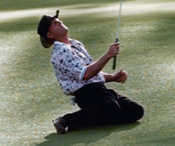 Greg Norman, 1996
Greg Norman, 1996
For the first three rounds of the 1996 Masters Tournament, Australian golfer Greg Norman played spectacularly well. He tied the lowest opening round score ever at Augusta National in Georgia and was leading by six strokes heading into the final day of competition. But in the final round, the Shark suddenly lost his bite, shooting six over par to lose by five strokes.
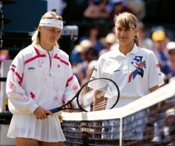 Jana Novotná, 1993
Jana Novotná, 1993
After dropping the first set of the 1993 Wimbledon final in a tiebreak, Czech tennis player Jana Novotná started crushing her German opponent Steffi Graf. Novotná won the next set 6-1 and was serving to go up 5-1 in the pivotal third set. A double fault turned the tide. Novotná lost her service game and every game after that. Graf won the third set 6-4.
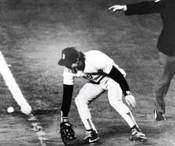 Bill Buckner, 1986
Bill Buckner, 1986
In game six of the 1986 World Series, the Boston Red Sox were up three games to two and tied with the New York Mets in the bottom of the 10th inning when Mets’ speedster Mookie Wilson hit a slow roller to Red Sox first baseman Bill Buckner. Buckner let the routine ground ball run through his legs, allowing the Mets to score the winning run.
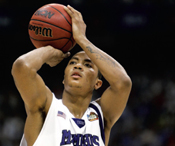 Memphis Tigers, 2008
Memphis Tigers, 2008
With two minutes to go in the 2008 NCAA Men’s Basketball Tournament, Memphis was leading Kansas by nine points. Down the stretch, Memphis All-Americans Derrick Rose (shown) and Chris Douglas-Roberts — who had collectively made their first six free throws of the game — made only one of their next five, allowing Kansas to tie the game and then win in overtime.
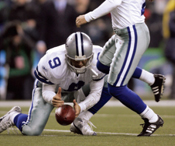 Tony Romo, 2007
Tony Romo, 2007
In the first round of the NFL playoffs, the Dallas Cowboys were losing by a touchdown to the Seattle Seahawks late in the game. With one minute to go, the Cowboys scored, but when they went to kick the extra point, quarterback Tony Romo — also the team’s placekick holder at the time — botched the snap, and the Cowboys lost by one.
From top: Phil Sandlin/Associated Press; Bob Martin/Getty Images; Boston Globe, Getty Images; Mark Humphrey/AP, Corbis; John Froschauer/AP







